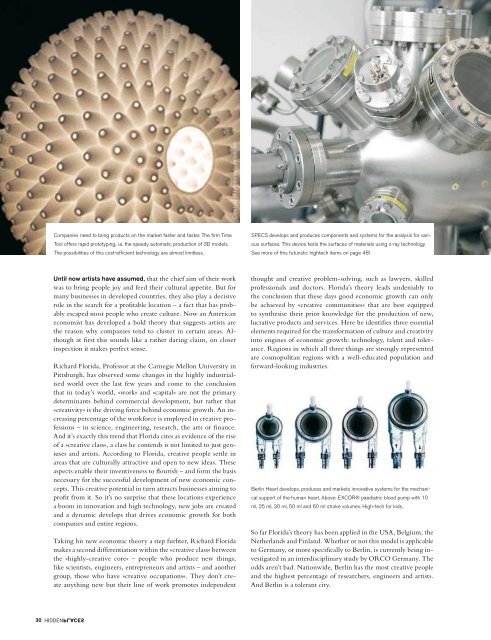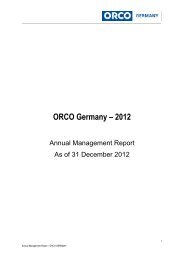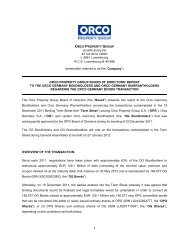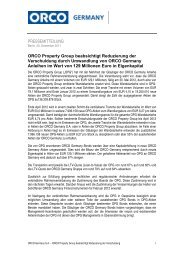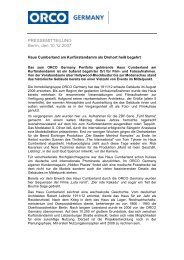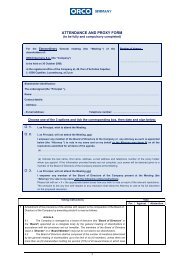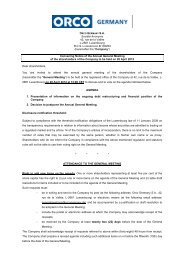PDF; 6,67 MB - ORCO Germany
PDF; 6,67 MB - ORCO Germany
PDF; 6,67 MB - ORCO Germany
Erfolgreiche ePaper selbst erstellen
Machen Sie aus Ihren PDF Publikationen ein blätterbares Flipbook mit unserer einzigartigen Google optimierten e-Paper Software.
Companies need to bring products on the market faster and faster. The firm Time<br />
Tool offers rapid prototyping, i.e. the speedy automatic production of 3D models.<br />
The possibilities of this cost-efficient technology are almost limitless.<br />
Until now artists have assumed, that the chief aim of their work<br />
was to bring people joy and feed their cultural appetite. But for<br />
many businesses in developed countries, they also play a decisive<br />
role in the search for a profitable location – a fact that has probably<br />
escaped most people who create culture. Now an American<br />
economist has developed a bold theory that suggests artists are<br />
the reason why companies tend to cluster in certain areas. Although<br />
at first this sounds like a rather daring claim, on closer<br />
inspection it makes perfect sense.<br />
Richard Florida, Professor at the Carnegie mellon university in<br />
Pittsburgh, has observed some changes in the highly industrialised<br />
world over the last few years and come to the conclusion<br />
that in today’s world, »work« and »capital« are not the primary<br />
determinants behind commercial development, but rather that<br />
»creativity« is the driving force behind economic growth. An increasing<br />
percentage of the workforce is employed in creative professions<br />
– in science, engineering, research, the arts or finance.<br />
And it’s exactly this trend that Florida cites as evidence of the rise<br />
of a »creative class«, a class he contends is not limited to just geniuses<br />
and artists. According to Florida, creative people settle in<br />
areas that are culturally attractive and open to new ideas. These<br />
aspects enable their inventiveness to flourish – and form the basis<br />
necessary for the successful development of new economic concepts.<br />
This creative potential in turn attracts businesses aiming to<br />
profit from it. So it’s no surprise that these locations experience<br />
a boom in innovation and high technology, new jobs are created<br />
and a dynamic develops that drives economic growth for both<br />
companies and entire regions.<br />
Taking his new economic theory a step furhter, Richard Florida<br />
makes a second differentiation within the »creative class« between<br />
the »highly-creative core« – people who produce new things,<br />
like scientists, engineers, entrepreneurs and artists – and another<br />
group, those who have »creative occupations«. They don’t create<br />
anything new but their line of work promotes independent<br />
Courtesy of freedomofcreation.com<br />
SPeCS develops and produces components and systems for the analysis for various<br />
surfaces. This device tests the surfaces of materials using x-ray technology.<br />
See more of this futuristic hightech items on page 48!<br />
thought and creative problem-solving, such as lawyers, skilled<br />
professionals and doctors. Florida’s theory leads undeniably to<br />
the conclusion that these days good economic growth can only<br />
be achieved by »creative communities« that are best equipped<br />
to synthesise their prior knowledge for the production of new,<br />
lucrative products and services. Here he identifies three essential<br />
elements required for the transformation of culture and creativity<br />
into engines of economic growth: technology, talent and tolerance.<br />
Regions in which all three things are strongly represented<br />
are cosmopolitan regions with a well-educated population and<br />
forward-looking industries.<br />
Berlin Heart develops, produces and markets innovative systems for the mechanical<br />
support of the human heart. Above: exCOr® paediatric blood pump with 10<br />
ml, 25 ml, 30 ml, 50 ml and 60 ml stroke volumes. High-tech for kids.<br />
So far Florida’s theory has been applied in the uSA, Belgium, the<br />
Netherlands and Finland. Whether or not this model is applicable<br />
to <strong>Germany</strong>, or more specifically to Berlin, is currently being investigated<br />
in an interdisciplinary study by <strong>ORCO</strong> <strong>Germany</strong>. The<br />
odds aren’t bad. Nationwide, Berlin has the most creative people<br />
and the highest percentage of researchers, engineers and artists.<br />
And Berlin is a tolerant city.<br />
Stylish temporary constructions for events, trade fairs and presentations developed<br />
by Kubix. They provide mobile aesthetics and design for the Berlinal Film Festival,<br />
Volkswagen and Sony ericsson (among others).<br />
These high scores in talent and tolerance have also encouraged<br />
developments in technology. more and more businesses from forward-looking<br />
industries such as biotechnology are calling Berlin<br />
home. Take for example the success story of scientist Christine<br />
Lang and her company Organo Balance. With her 22-strong research<br />
team, Lang developed a new strain of bacteria that fights<br />
tooth decay. It’s the first of its kind. Chemical giant BASF will<br />
manufacture a bacteria-containing toothpaste and plans to have<br />
this revolutionary product on shelves by the end of the year.<br />
Just as exciting are the leaps and bounds being made by Berlin’s<br />
film and fashion industries. And many businesses are profiting<br />
from this growth, such as markus Block’s kubix Berlin, which<br />
assembles stylish temporary constructions for high-profile events.<br />
The Berlinal Film Festival, Volkswagon and Sony ericsson are<br />
heavy-weight players on the cultural scene thanks to companies<br />
like kubix.<br />
No less exceptional is the current boom being experienced by<br />
mid-sized businesses. The relocation of the federal government<br />
lured a multitude of service providers, media companies and business<br />
subsidiaries to the capital, transforming Berlin into a forum<br />
for international politics, public relations and global economic<br />
relations. Growth in the solar energy industry has also been particularly<br />
encouraging. Tremendous levels of investment and jobcreation<br />
have made Berlin an international leader in photovoltaics.<br />
A company called SOALRC has profited indirectly from this<br />
economic upturn. Their »SoLait« solar-powered designer milk<br />
frother has triggered a world-wide trend in solar-powered consumer<br />
products.<br />
Such positive indications suggest that the <strong>ORCO</strong> study will find<br />
a »creative class« in Berlin in line with Florida’s theory. This<br />
would confirm the already positive signs for Berlin’s economic<br />
future. Thirty years after the fall of the wall, Berlin could soon<br />
become an economic heavy-weight on par with renowned creative<br />
centres like San Francisco and makes the win in economical<br />
issues of the future.<br />
30 31<br />
ww<br />
Richard Florida, The Rise of the Creative Class (2002): according to<br />
Richard Florida, members of the creative class hold approximately 30 % of<br />
all jobs in the uSA. His definition includes not only journalists, designers<br />
and artists, but also managers, doctors and lawyers. The creative class move<br />
to regions that fulfil their need for creative employment and motivate<br />
them towards greater innovation. As a rule, that means metropolitan areas<br />
offering a diverse range of culture and art as well as open and interesting<br />
people. The typical process of location selection has been turned on its<br />
head: people are no longer moving to regions full of lucrative businesses<br />
and employers. Instead, companies are increasingly settling in regions with<br />
the highest concentration of potential employees. members of the creative<br />
class determine a region’s economic growth. The decisive factors are technology,<br />
talent and tolerance. Florida is the first person to name tolerance as<br />
THe most essential factor in »TTT« (technology: innovation, inventions;<br />
talent: the promotion of education and improving the educational system;<br />
tolerance: the numbers of gays, bohemians and racist incidents in a city).<br />
Richard Florida, The Rise of the Creative Class (2002): Laut Richard Florida<br />
machen die mitglieder der Creative Class in den uSA circa 30 Prozent<br />
aller Arbeitsplätze aus. es handelt sich hierbei um Journalisten, Designer<br />
und Künstler, aber auch um manager, Ärzte und Anwälte. Die Creative<br />
Class zieht es in bestimmte Regionen, die ihre Bedürfnisse, kreativ tätig<br />
zu werden, erfüllen und sie zu innovativem Handeln motivieren. In der<br />
Regel handelt es sich hierbei um metropolen mit einem breit gefächerten<br />
Angebot an Kultur, Kunst und offenen und interessierten menschen. Das<br />
übliche muster der Standortwahl dreht sich also um: Die menschen ziehen<br />
nicht mehr in die Regionen, in denen sich die lukrativen unternehmen<br />
und Arbeitgeber befinden. Vielmehr siedeln sich die unternehmen vermehrt<br />
in den Regionen an, wo die Dichte potenzieller Arbeitnehmer am<br />
größten ist. Die mitglieder der Creative Class bestimmen das ökonomische<br />
Wachstum einer Region. Dabei sind die Faktoren Technologie, Talent<br />
und Toleranz einer Region entscheidend. Florida ist der erste, der bei dem<br />
TTT-Potenzial (Technologie: Innovationen, erfindungen; Talent: hängt<br />
von der schulischen Förderung und der Verbesserung des Schulsystems ab;<br />
Toleranz: gemessen am Bohemian, Gay and Racism Index einer Stadt) die<br />
Toleranz als DeN essenziellen Faktor hervorhebt.


